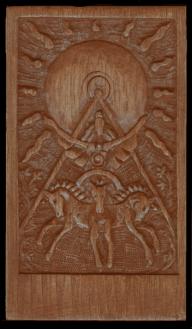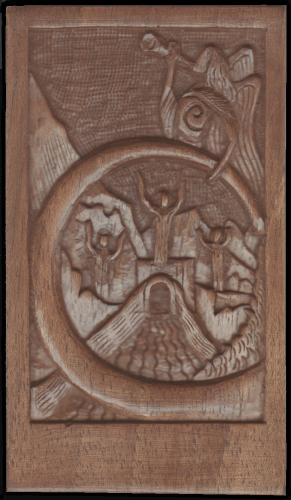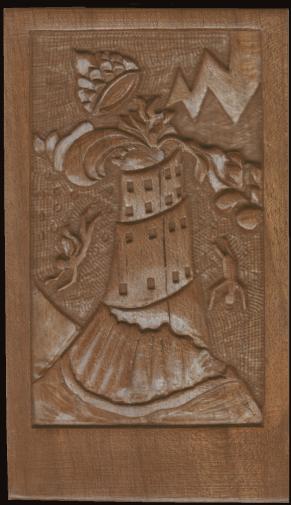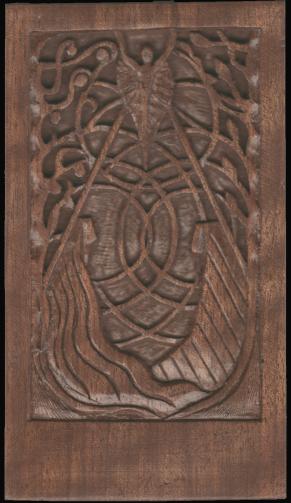 The Kashmir Tarot
The Kashmir Tarot In 1982 the Dutch artist Nicolaas van Beek travelled to Kashmir to work on the designs for a tarot deck which would unite Eastern esoteric concepts of the chakras with Western tarot imagery. Having created designs on paper he decided to make a wooden deck in bas-relief on small plaques of walnut. The first deck he made himself, but during this time he met a highly skilled Kashmiri wood carver called Abdul Salama, and commissioned him to help with making a further seven decks. On his return to the Netherlands van Beek decided to work his designs into a printed form, using serigraphy. He worked for nearly two years with some assistance from Dutch artist Dik Al to make these complex serigraphs, which used many layers (up to twenty) of ink on a card. Six copies of the Wooden Kashmir were sold, mainly to well known collectors in the Netherlands, and two found their way to the USA. Apparently one of the seven production remains in the hands of the artist. You can see his current wide range of artworks on www.nicolaascjvanbeek.com The "deck" consists of 22 plaques of walnut about 1/4 of an inch (6mm) thick and around 3 1/2 inches (88mm) high by 2 inches (50mm) wide. These were smoothed and polished and the carving made in low relief in an off-centred window set into the upper surface. This offsetting of the carved area immediately gives the impression of a tarot card with space at the bottom for text. There is no card title or number but as the designs closely reflect the established tarot arcana there is no problem in recognising the arcanum being depicted. The image stands out from a background which is textured with a punch hammered into the carved away surface. The forms of the image are for the most part smooth, being cut by a sharp chisel, and perhaps later burnished. Walnut is a hard wood with a fine grain, and it thus supports fine relief lines, which are stable and not easily damaged, as they can be on softer or more coarsely grained woods. Kashmir is home to the finest quality of walnut wood in the world and is the only state in India where walnut grows. Kashmiri craftsmen are renowned for their fine carving in walnut, and the Kashmir Tarot is a prime example of this skill. In comparing my copy with the photographs of another copy in Kaplan's Encyclopedia Vol III, I noticed many variations in the carvings. Thus these were not mere slavish copies, but each image was created anew reflecting the individual structure of the grain of the pieces of wood and the creative exploration of the carver as he worked through making seven copies of each image. Here we can see this tooled background on the Sun plaque. Here we can see another feature of the carving, the higher foreground of the three horses and an intermediate layer of vegetation (here towards the right and left edges) lying between this and the background. Ths subtle feature helps give a sense of depth to the imagery.      Some of the imagery is conventional tarot, and example of which is The Tower. In other designs van Beek incorporates lines of rays and circles of energy, reflecting his interest in the chakras. We see this clearly in The Lovers. ...to be continued |
Tarot exhibitions. The Masjutin Tarot - probably the first art tarot. The Mebes (1937) Tarot. The Kashmir Tarot. The Chapel at Avenieres. Projects in progress
Descriptive Database of published tarots. This is initially based on my own collection. About 1100 items have been entered into the database to date, and I have appointed an art history student to work with me over the coming months to complete the listing. So expect further updates over the next few months. Descriptive Database of unpublished tarots. In parallel with the descriptive catalogue of published tarots I have been able to find a colleague, Stacy Flinn, here in Scotland, willing to help build a catalogue of unpublished tarot designs. I myself have gathered some hundreds of these over the last years and as some of these are astounding, it would be good to have these in a catalogue which I could eventually place on this website. I will report on progress with this later and post the database onto the web site. I have called on members of the Tarot Collectors Forum to help by sharing information about such unpublished tarots. Funding through series of private auctions. In order to raise some funding for projects, I am planning a series of auctions of duplicates from my tarot collection. These will be private auctions only open to those who have registered in advance by emailing [email protected] |

 Facebook page
Facebook page